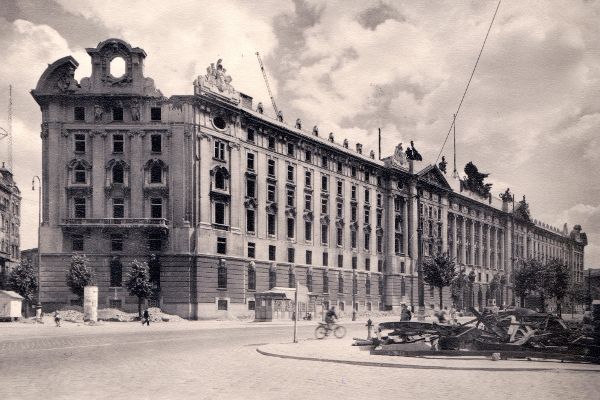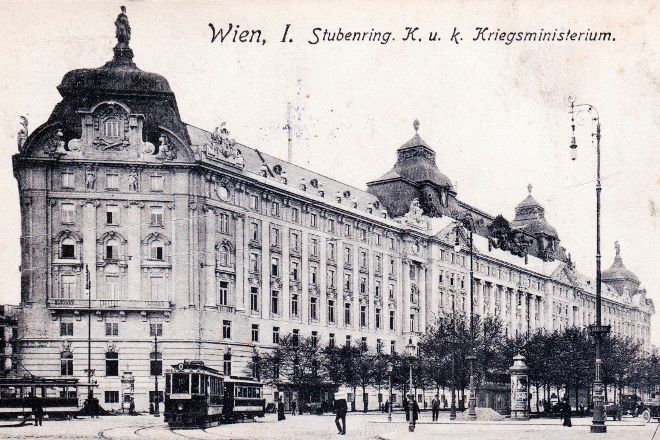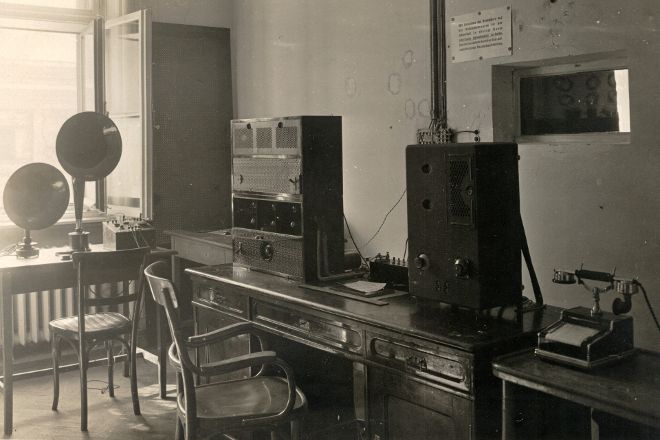The government building - stormy years

From 1918 to 1952 the Government Building witnessed the struggle between democracy and dictatorship, destruction and reconstruction – reflecting much of Austria's tumultuous history during this time.
The collapse of the Danube Monarchy after the First World War also had serious effects on the administration centre Vienna. The War Ministry Building, initially intended for an empire with a population exceeding 50 million, all at once was vastly oversized. Yet with the State Office for Armed Forces, it was reserved for military administration matters for the time being. Here efforts were soon underway to establish the new Federal Armed Forces, upon which the building was to become one of the most important settings for the First Republic's political conflicts.
From 1924 onward, the edifice was increasingly being opened for civilian use: The Federal Ministry of Trade, Commerce and Transportation, the Federal Building Administration, the Patent Office and a branch of the Italian Chamber of Commerce moved in. In late 1924, this was also where the RAVAG, Austria's first broadcasting organisation, finally went into operation. A wind of change swept through the ostentatious building, which, by then, seemed increasingly anachronistic. In 1934, further ministries moved in, among them one for agriculture and forestry.
Den of despotism
With Austria's annexation to the German Reich, the Government Building was one of the first ones to be taken over by the new ruling powers, so once again the civilian facilities were forced to leave the building. After the XVII Army Corps of the German Army (Wehrmacht) moved in, the building was to become one of the most central political linchpins in what was now referred to as "Ostmark". So the building, designed for the case of war, once again returned to its originally intended use – this time against the background of a criminal regime that was about to lead the entire continent into an abyss of apocalyptic proportions.
Various Nazi courtrooms were distributed across three floors. Having plenty of experts at their disposal who were keen to collaborate, there was no need for the military tribunals to resort to judges and lawyers from the "old Reich" (i.e. Germany). More and more administrative and staff officers from the Wehrmacht moved in who were involved in the planning and conducting of military campaigns.
In this respect, based on what is known to day, it is necessary to put the actual scope of the Stubenring resistance group surrounding Major Carl Szockoll into perspective. The actual impact of their undoubtedly ambitious plans was in fact very limited. During the time leading up to the city's occupation, the Government Building remained a den of despotism bearing testimony to a reign of terror.
In the shadow of war
The building initially survived military action largely intact. It was not until the Vienna Offensive that the building was severely damaged. In March 1945 five bombs struck, leading to explosions in several of the ammunition depots inside the building. In April, a fire that lasted several days devastated large parts of the building. Almost all of the roof timbers including the dome-shaped roof structures went up in flames. What remained was a building in ruins with burned out walls and collapsed ceilings. The heating system, electric lines and lifts had stopped working, the brickwork was cracked and splintered and much of the flooring and many windows and doors were completely destroyed. Such was the level of damage that people were considering its demolition.
In autumn 1945 the Allies handed the ravaged building over to the new government. It was quickly decided to have the building rebuilt and used for administration purposes. The by that time fully visible extent of destruction and the general supply shortages posed a tremendous challenge to those responsible for its reconstruction. At first it was necessary to remove enormous amounts of rubble and carefully defuse any hidden bombs and mines.
The final go-ahead for reconstruction was given in 1949. Eugen Ceipek, who was the son of the original builder Josef Edler von Ceipek, was appointed construction manager. In total, one million bricks, 2.3 tonnes of cement and 200,000 tonnes of concrete steel were needed. Considering the persisting lack of building materials, these were staggering amounts, and it came as no surprise that construction work was plagued by constant delays.
Practicability instead of pomp
During reconstruction, the building underwent some major structural modifications. Large portions of the façade including the roof-scape received a new look. The originally rather pompous domes were replaced by a functional saddle roof. By adding two floors to Hof 1, space was created for another 120 offices. The furnishing of the marble hall had been badly damaged by the war. Following elaborate renovation work it was, however, possible to use the ceremonial room for representation purposes, even though a number of details were lost forever. On the other hand, the tapestry hall's interior was that badly damaged that to restore it to its original splendour was out of the question. These days, only old photographs can give us some indication of its former glory.
In 1952, the renovation work was largely completed, and the first civil servants of the Second Republic started working in the venerable old rooms.
Further information
-

The government building - the beginnings
The government building at Stubenring has a long, eventful history of more than a hundred years. In this time, a wide variety of institutions were based in the famous building. Today, it serves as the seat of four ministries. -

The government building - a piece of radio history
In the government building on Stubenring radio history was made: The building was home to the country's very first radio studio and housed the "Stubenring Transmitter".